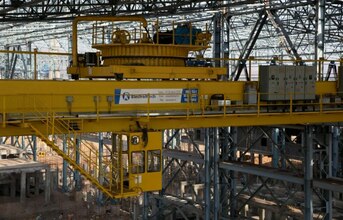
Furnace and rolling mills: The furnace is served by a 10MT crane with 22m span, which also has a rigorous initial application of installing the furnace and rollers. Once the installation of the furnace is completed, the crane will be used for replacing the rollers and for regular maintenance applications. Once the billets are transferred to the furnace for heat treatment purpose, they pass through idle rollers where they are re-heated. Two cranes serve this area; one crane of capacity 25/5MT with 28m span and another of 20/5MT capacity and 34m span. Since the dies have to be changed depending on the product to be manufactured, the 25/5MT crane is in constant use. All these cranes are designed for class 3 duty.
Quenching and cooling: Rolling is followed by the quenching and cooling of rolled items. The material to be handled in this stage is in the form of bundles and the same continues till the despatch of the final product. Here, two 15MT, 28m span, class 3, double girder cranes are installed to assist the installation of the machinery during plant set u stage and later on will be used to handle the material being processed at this bay.
In the steel melting shop (SMS) where billets are formed, a total of four cranes with rotating trolleys assist in the manufacturing and storage of the billets. Two cranes of 20MT each covering a span of 32.8m and another two 20MT cranes with 27.2m span cover the manufacturing and storage of the billets before they are sent for further processing.
Since these cranes are part of a process and in constant use, these are designed for class 4 duty. The ambient temperature in the steel melting shop is approximately 060 Celsius, requiring all the components of the crane to be able to withstand such high temperatures. Hence, a slewing wheel type of arrangement was selected to be able to work in this area. An air-conditioned cabin is also provided for the operator.
Despatch
Once the processing of the material is complete, it moves towards the despatch bay. The despatch bay is 380m in length and is entirely covered by 3 nos. 12.5MT, 34m span, class 3 duty cranes. Like in the case of the steel melting shop cranes, these cranes also have 360 degrees rotating crabs, however, the mechanism used here is a slewing bearing. This mechanism was narrowed down upon after many discussions between the design team of ElectroMech and BMM team. There were two types of rotating mechanisms that were finalised - one that operates with the help of gears and the other by using rails and wheels.
The first one is used for continuous operations and hence the maintenance had to be kept to the lowest possible. The latter crane was operated under normal working conditions hence easy accessibility and simple mechanisms had to be provided. Since the despatch bay is in continuous operation, the cranes installed here are used rigorously for loading of finished components. The other two cranes will be used to load and unload materials onto despatch vehicles into the respective parking areas. The client team and ElectroMech team worked closely to develop a suitable system and commission it in the stipulated time span.
Source: ElectroMech
END


























